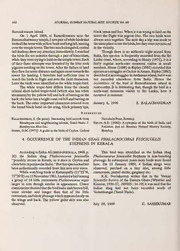
Occurrence of the Indian shag Phalacrocorax fuscicollis Stephens in Kerala PDF
Preview Occurrence of the Indian shag Phalacrocorax fuscicollis Stephens in Kerala
442 JOURNAL, BOMBAYNATURALHIST. SOCIETY, Vol. 88 Rameshwaram island. blacktarsusand feet. Whenitwas tryingto land onthe On 1 April 1989, at Rameshwaram near the tower the flight was pigeon-like. The two birds were Ramanathaswamytemple,Isawpairofwhitebirdsthat always seen together. The next day a trip was made to lookedliketernswith yellowbeakandlongtail,soaring thesameplacetoseethebirds,buttheywerenotnoticed overthetempletower.Thetwomuch elongated, central in the vicinity. tail feathers drew my attention immediately. Iwatched Though there is no authentic sight record from the birds for ten minutes through a pair ofbinoculars, India, this species is frequently recorded fromthe Sri whiletheyweretryingtolandonthetempletower.Each Lanka coast, where, according to Henry (1971), it is a oftheir three attempts was thwarted by the blue rock fairly regular north-east monsoon visitor in small pigeons residing on the tower. Afterthe failure to land numbers. Hume (1888) in Ripley (1982) recorded this they flewforsomedistanceandagaincametowardsthe speciesasastraggleratCacharinAssam.Ripley (1982) tower for landing. I therefore had sufficient time to described itasastraggler inAndamanisland,butitwas watch the birds in flight and note the field characters. not recorded elsewhere from India. Hence the Laterthebirds were identified asthe white tropic-bird. occurrence of the bird at Rameshwaram island is The white tropic-bird differs from the closely noteworthy. It is interesting that, though the bird is a related short-tailed tropic-bird (which also has white north-east monsoon visitor to Sri Lanka, here it streamers)by the yellowbill and lack ofbarringon the occurred in summer. back; thelatterhasabrightcoral redbill andbarringon BALACHANDRAN the back. The other important characters noticed were January 6, 1990 S. the broad black band on the wing, black primary tips, ReferENCES Balachandran, S. (In press): Interesting bird records from UniversityPress,Bombay. A Mandapam and neighbouring islands, Tamil Nadu. J. Ripley, S.D. (1982): synopsis of the birds of India and Bombaynat.Hist.Soc. Pakistan. 2nd ed. Bombay Natural History Society, A Henry, G.M. (1971): guide to the birds ofCeylon. Oxford Bombay. OCCURRENCE OF THE INDIAN SHAG PHALACROCORAX FUSCICOLLIS 4. STEPHENS IN KERALA AccordingtoSalimAli (birdsofkerala, 1969,p. This bird was identified as the Indian shag 20) the Indian shag Phalacrocorax fuscicollis Phalacrocorax fuscicollis Stephens in non-breeding “possibly occurs in Kerala, as it does in Ceylon and plumage. In subsequent years more birds were found elsewhere inpeninsularIndia.”Butthisspecieshadnot here. On 15 January 1989, 4 Indian shags were been authentically recorded from this area ever since. observed, perched on a tiny islet, among little While watching birds at Kattampally (11°55’N, cormorants, pintail ducks, garganey etc. 75°20’E)on 15November 1981,1noticedabirdamong K.K. Neelakantan writes that in the Vemay a group of 14 little cormorants Phalacrocorax niger Scientific Survey of the Eastern Ghats (Whistler and larger in size though similar in appearance. Closer Kinnear, 1930-37, JBNHS : 34-39) itwas said that the examinationshowedthatthebirdhada darkbrownbill, Indian shag had not been recorded south of more slender and longer than that of the little Vedanthangal (Tamil Nadu). cormorant,andblackplumagewhichappearedscaly on the wings and back. The yellow gular skin was also SASHIKUMAR observed. July 19, 1989 C.
